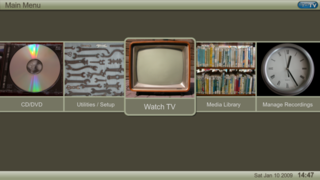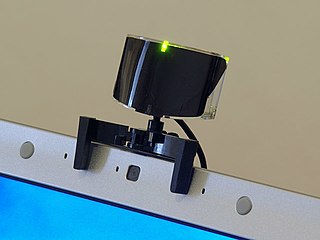
A webcam is a video camera which is designed to record or stream to a computer or computer network. They are primarily used in video telephony, live streaming and social media, and security. Webcams can be built-in computer hardware or peripheral devices, and are commonly connected to a device using USB or wireless protocols.

In electronics, a remote control is an electronic device used to operate another device from a distance, usually wirelessly. In consumer electronics, a remote control can be used to operate devices such as a television set, DVD player or other digital home media appliance. A remote control can allow operation of devices that are out of convenient reach for direct operation of controls. They function best when used from a short distance. This is primarily a convenience feature for the user. In some cases, remote controls allow a person to operate a device that they otherwise would not be able to reach, as when a garage door opener is triggered from outside.

Pro Tools is a digital audio workstation (DAW) developed and released by Avid Technology for Microsoft Windows and macOS. It is used for music creation and production, sound for picture and, more generally, sound recording, editing, and mastering processes.
An application program is a computer program designed to carry out a specific task other than one relating to the operation of the computer itself, typically to be used by end-users. Word processors, media players, and accounting software are examples. The collective noun "application software" refers to all applications collectively. The other principal classifications of software are system software, relating to the operation of the computer, and utility software ("utilities").

MythTV is a free and open-source home entertainment application with a simplified "10-foot user interface" design for the living room TV. It turns a computer with the necessary hardware into a network streaming digital video recorder, a digital multimedia home entertainment system, or home theater personal computer. It can be considered a free and open-source alternative to TiVo or Windows Media Center. It runs on various operating systems, primarily Linux, macOS, and FreeBSD.

Windows Movie Maker is a discontinued video editing software program by Microsoft. It was first included in Windows Me on September 14, 2000, and in Windows XP on October 25, 2001. It later became a part of the Windows Essentials software suite, and offered the ability to create and edit videos as well as to publish them on OneDrive, Facebook, Vimeo, YouTube, Windows Live Groups, and Flickr. It is comparable to Apple's iMovie.

AMX is an American manufacturer of video switching and control devices. It is currently owned by Harman International Industries, a subsidiary of Samsung Electronics and is part of the Harman Professional Division.

The Apple Remote is a remote control introduced in October 2005 by Apple Inc. for use with a number of its products with infrared capability. It was originally designed to control the Front Row media center program on the iMac G5 and is compatible with many subsequent Macintosh computers. The first three generations of Apple TV used the Apple Remote as their primary control mechanism. It has now been replaced with the Siri Remote in the fourth generation. Prior to the Apple Remote, Apple produced several nameless IR remotes for products such as the Macintosh TV, TV tuner expansion boards, and the PowerCD drive.
Sony's LocationFree is the marketing name for a group of products and technologies for timeshifting and placeshifting streaming video. The LocationFree Player is an Internet-based multifunctional device used to stream live television broadcasts, DVDs and DVR content over a home network or the Internet. It is in essence a remote video streaming server product. It was first announced by Sony in Q1 2004 and launched early in Q4 2004 alongside a co-branded wireless tablet TV. The last LocationFree product was the LF-V30 released in 2007.
Amiga software is computer software engineered to run on the Amiga personal computer. Amiga software covers many applications, including productivity, digital art, games, commercial, freeware and hobbyist products. The market was active in the late 1980s and early 1990s but then dwindled. Most Amiga products were originally created directly for the Amiga computer, and were not ported from other platforms.

A projection keyboard is a form of computer input device whereby the image of a virtual keyboard is projected onto a surface: when a user touches the surface covered by an image of a key, the device records the corresponding keystroke. Some connect to Bluetooth devices, including many of the latest smartphone, tablet, and mini-PC devices with Android, iOS or Windows operating system.

A digital media player is a type of consumer electronics device designed for the storage, playback, or viewing of digital media content. They are typically designed to be integrated into a home cinema configuration, and attached to a television or AV receiver or both.
The Nokia 6000 series or Classic Business series is range of mobile phones marketed by Nokia. This family of phones is notable for their conservative, unisex designs, making them popular with business users.

FreeTrack is a general-purpose optical motion tracking application for Microsoft Windows, released under the GNU General Public License, that can be used with common inexpensive cameras. Its primary focus is head tracking with uses in virtual reality, simulation, video games, 3D modeling, computer aided design and general hands-free computing to improve computer accessibility. Tracking can be made sensitive enough that only small head movements are required so that the user's eyes never leave the screen.

BB FlashBack is a Windows-based screen recording program, distributed by Blueberry Software. It allows the user to add text effects, cut and paste movie footage and edit mouse movements. Recordings are initially saved in a proprietary format which can be opened and edited in the associated editor. Once editing is complete they can be exported to Flash, AVI, and a variety of other formats. A PowerPoint plug-in is also deployed with the program's installer. A freeware version of this program was released in April 2009.
Proprietary software is software that grants its creator, publisher, or other rightsholder or rightsholder partner a legal monopoly by modern copyright and intellectual property law to exclude the recipient from freely sharing the software or modifying it, and—in some cases, as is the case with some patent-encumbered and EULA-bound software—from making use of the software on their own, thereby restricting their freedoms.

Kinect is a discontinued line of motion sensing input devices produced by Microsoft and first released in 2010. The devices generally contain RGB cameras, and infrared projectors and detectors that map depth through either structured light or time of flight calculations, which can in turn be used to perform real-time gesture recognition and body skeletal detection, among other capabilities. They also contain microphones that can be used for speech recognition and voice control.
Project Digits is a Microsoft Research Project under Microsoft's computer science laboratory at the University of Cambridge; researchers from Newcastle University and University of Crete are also involved in this project. Project is led by David Kim a Microsoft Research PhD and also a PhD Student in computer science at Newcastle University. Digits is an input device which can be mounted on the wrist of human hand and it captures and displays a complete 3D graphical representation of the user's hand on screen without using any external sensing device or hand covering material like data gloves. This project aims to make gesture controlled interfaces completely hands free with greater mobility and accuracy. It allows user to interact with whatever hardware while moving from room to room or walking down the street without any line of sight connection with the hardware.

Guvcview is a webcam application, i.e. software to handle UVC streams, for the Linux desktop, started by Paulo Assis in 2008. The application is written in C and is free and open-source software released under GPL-2.0-or-later.

Logitech Harmony is a line of remote controls and home automation products produced by Logitech. The line includes universal remote products designed for controlling the components of home theater systems and other devices that can be controlled via infrared, as well as newer smart home hub products that can be used to additionally control supported Internet of things (IoT) and Smart home products, and allow the use of mobile apps to control devices. On April 10, 2021, Logitech announced that they would discontinue Harmony Remote manufacturing.














